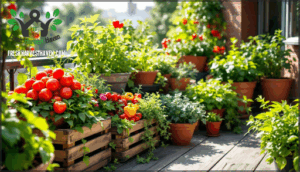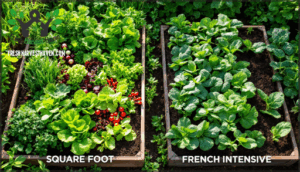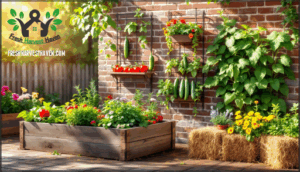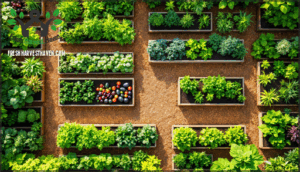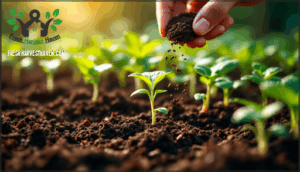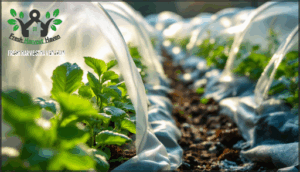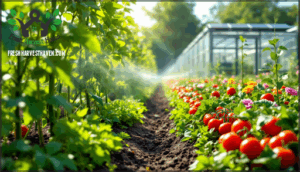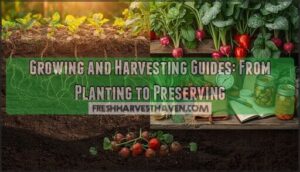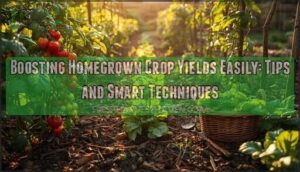This site is supported by our readers. We may earn a commission, at no cost to you, if you purchase through links.
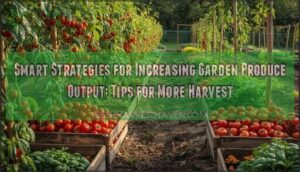
Small adjustments in how you arrange your garden, feed your soil, and protect your crops can double or triple your harvest without expanding your growing space. Whether you’re working with containers on a balcony or rows in a backyard, the right techniques transform modest efforts into abundant yields that keep your kitchen stocked all season long.
Table Of Contents
Key Takeaways
- Strategic plant selection matters more than space size—hybrid tomatoes, pole beans, and zucchini deliver 10-15 pounds per plant in minimal space, while succession planting every two weeks keeps harvests flowing continuously from spring through fall.
- Soil health creates the foundation for abundant yields through regular additions of 2-3 inches of compost, crop rotation to break disease cycles, and organic amendments like comfrey tea that boost production without synthetic fertilizers.
- Smart space utilization through vertical growing, raised beds, and intensive planting methods like Square Foot Gardening can double or triple output from the same footprint by maximizing every available inch.
- Season extension techniques including cold frames, row covers, and winter sowing of cold-hardy crops add weeks or months to your growing window, turning dormant seasons into productive time that multiplies annual harvests.
Choosing High-Yield Plants for Your Garden
Your plant choices can make or break your harvest totals. Some varieties naturally produce more food in less space, while others keep giving throughout the season with minimal effort.
Let’s look at the top performers that’ll help you get the most out of every square foot of your garden.
Best Vegetable Varieties for Productivity
When you’re chasing crop yield, start with hybrid tomatoes like ‘Early Girl’ or ‘Celebrity’—they’ll give you 10-15 pounds per plant and strong disease resistance. Zucchini varieties like ‘Black Beauty’ produce about 10 pounds each season with minimal fuss. Pole beans such as ‘Kentucky Wonder’ deliver steady harvests in tight spaces.
Match your vegetable varieties to your climate adaptability needs and space requirements for peak harvest timing that works.
Selecting Quick-growing and Succession Crops
Once you’ve picked your powerhouse plants, the next move is lining up quick crops that fill the gaps and keep your garden producing week after week. Fast-maturing vegetables like radishes (25 days), lettuce (30 days), and spinach (40 days) give you quick wins.
Use succession planting strategies—sow new seeds every two weeks for continuous harvest. This staggered planting approach keeps your crop yield steady through seasonal planning and smart crop rotation.
Companion Planting for Increased Yields
Beyond rotating crops quickly, companion planting strategies boost your garden’s output naturally. Plant basil near tomatoes for pest control—yields jump and fruit quality improves.
Try corn, beans, and squash together (the "Three Sisters")—this intercropping method increases grain yields up to 13% while enriching soil health.
Strawberries paired with borage deliver 35% more fruit through better pollination and pest suppression, proving companion planting delivers real economic returns.
Growing Perennial and Space-saving Crops
Perennials like asparagus, rhubarb, and artichokes pay you back year after year without replanting, while vertical crops like pole beans and vining cucumbers deliver big harvests from tiny footprints.
Stack in time and space by layering quick-to-grow crops beneath taller perennials—lettuce thrives under asparagus fronds. This space efficiency turns every square inch into productive ground, especially valuable for small space gardening where crop selection matters most.
Optimizing Garden Layout and Space Utilization
Getting more produce from your garden isn’t just about what you grow—it’s about how you arrange it. The way you organize your space can make the difference between a modest harvest and baskets overflowing with vegetables.
Let’s look at some smart layout strategies that help you grow more in whatever space you have.
Maximizing Small Spaces With Container Gardening
You don’t need acres of land to grow a serious harvest—just a few well-chosen containers and some smart planning. Container gardening techniques let you grow tomatoes, peppers, herbs, and greens anywhere there’s sunlight exposure. Match container size to your plants’ needs, use quality potting mixes, and keep watering needs consistent for maximum yields.
Keys to small space gardening success:
- Choose containers at least 12 inches deep for vegetables like tomatoes and peppers
- Use lightweight potting mixes that drain well and hold nutrients
- Pay attention to plant spacing—crowded containers reduce production
- Position containers where they’ll get 6-8 hours of sun daily
Square Foot and French Intensive Gardening Methods
Two proven methods can turn limited garden space into a productivity powerhouse. The Square Foot Gardening method divides beds into one-foot grids—plant sixteen carrots or four lettuces per square using Mel’s Mix for resource efficiency.
French Intensive gardening relies on double digging and intensive planting, where mature leaves barely touch. This approach, also known as French Intensive gardening, originated in 19th-century France.
Both approaches excel at maximizing garden production through succession crops and smart spacing.
Raised Beds, Vertical, and Straw Bale Techniques
Raised beds bring the soil up to you, vertical gardens send plants skyward, and straw bales offer a no-dig shortcut—three techniques that solve different space and soil challenges in remarkably practical ways.
Raised beds improve drainage and warm up faster in spring. Vertical structures like trellises and towers turn walls into growing zones for beans and cucumbers. Straw bales, once conditioned with nitrogen, become instant gardens that skip bed construction entirely.
- Raised beds offer easy-to-build structures that promote water efficiency and reduce soil compaction
- Vertical gardening techniques get the most out of space by training vining crops upward on frames and structures
- Straw bale gardening provides immediate planting after a two-week prep period with added nutrients
Designing Beds for Accessibility and Productivity
A well-planned bed layout transforms gardening from a wrestling match with awkward angles into a smooth operation where everything you need is within arm’s reach. Permanent beds with paths in between allow you to access plants from all sides without compacting the soil. Aim for beds no wider than four feet so you can reach the center comfortably—that’s Ergonomic Bed Design at work.
Block planting in Intensive Planting Layouts makes every inch count, maximizing bed space while giving roots room to spread.
| Bed Dimension | Best For | Spacing Benefits |
|---|---|---|
| 3-4 ft wide | Accessibility | Easy reach from both sides |
| 6-12 ft long | Efficient Bed Shapes | Flexible Succession Planting |
| 6-8 inches tall | Raised Beds | Better drainage and warmth |
| 18-24 in paths | Accessible Garden Paths | Room for wheelbarrows |
Enhancing Soil Health and Plant Nutrition
Your soil is the foundation of your garden’s success. Healthy, nutrient-rich ground produces stronger plants and bigger harvests.
Here are four practical ways to improve your soil and feed your plants naturally.
Building Nutrient-rich Soil With Organic Matter
Think of organic matter as the lifeblood of healthy soil—without it, plants struggle to reach their potential. Building nutrient-rich soil starts with regular additions of compost, aged manure, or leaf mold to boost soil organic matter levels.
Here’s how to strengthen your soil health:
- Add 2-3 inches of compost each season to increase soil organic matter from 1% to 3%, reducing erosion by up to 33%.
- Layer organic matter in winter so it breaks down naturally before spring planting.
- Apply surface mulch to slow moisture loss and feed soil microbes year-round.
- Combine amendments like biochar with compost to improve soil structure and boost carbon levels by over 25%.
These practices create the foundation for nutrient-rich soil that fosters stronger roots and higher yields. High organic matter content is important because it promotes microbial diversity.
Composting, Mulching, and Natural Fertilizers
Composting and mulching work like a savings account for your garden—you’re constantly investing in soil fertility that pays dividends with every harvest. Start your compost pile with kitchen scraps and yard waste to create nutrient-rich amendments for free.
Apply 2-4 inches of organic mulch around plants to retain moisture and suppress weeds. Boost hungry crops with liquid seaweed or homemade comfrey tea for quick nutrition.
Incorporating Crop Rotation and Green Manures
Rotating crops and planting green manures between harvests rebuilds soil health without spending a dime. Rotation benefits include pest reduction and improved soil enrichment, while green manures add nitrogen and organic matter. Planning rotations keeps your garden thriving year after year:
- Move plant families to different beds each season to break disease cycles
- Sow cover crops like clover or rye during off-seasons for soil enrichment
- Follow heavy feeders with nitrogen-fixing legumes to restore nutrients
Using Comfrey and Organic Feeding Solutions
Once you’ve got your beds rotating and cover crops working, comfrey and other organic feeds give your hungry plants the extra boost they need during peak growing season. Comfrey tea packs a nutrient punch for tomatoes and peppers, while liquid seaweed helps prevent nutrient deficiencies across the board.
Regular feeding schedules keep plants productive throughout the season.
| Organic Fertilizer | Best For | Application Timing |
|---|---|---|
| Comfrey tea | Tomatoes, peppers, squash | Every 2-3 weeks during fruiting |
| Liquid seaweed | All vegetables | Weekly foliar spray |
| Fish emulsion | Leafy greens | Every 10-14 days |
Extending The Growing Season and Protecting Plants
One of the smartest ways to boost your harvest is to keep plants producing beyond their normal season. You can shield crops from cold and extend your growing window with the right protection.
Here’s what works best for keeping plants safe and productive when temperatures drop.
Using Cold Frames, Row Covers, and Cloches
When you slip a protective cover over your plants, you’re giving them a head start that can stretch your growing season by weeks or even months. Cold frames act like miniature greenhouses, while row covers and cloches offer frost protection and pest control.
These tools create warmer microclimates that let you extend harvest times. You can buy them ready-made or build DIY options from materials you already have.
Strategies for Winter and Early Spring Gardening
You’re already using cold frames and covers to protect tender plants. Now let’s make the most of winter and early spring by actively growing cold-hardy crops for earlier harvests. Direct sowing spinach in mid-winter can produce pickings by April—weeks ahead of spring plantings. Cover crops like winter rye build soil fertility while holding ground until spring.
Here’s how to make the most of these cooler months:
- Sow cold-hardy crops like kale, winter lettuce, arugula, and carrots directly into frozen soil; they’ll germinate when temperatures rise
- Start seeds indoors during winter to gain up to 6 weeks on your growing season for tomatoes and peppers
- Use tight spacing or block planting with succession crops to make the best use of space and reduce weeds by 40%
- Apply organic mulch in winter to boost soil moisture by 10–14% and stabilize temperature swings
- Plant green manures such as hairy vetch to fix nitrogen naturally and suppress spring weeds
Season extension through winter gardening turns dormant months into productive ones.
Protecting Plants From Frost and Pests
Between a late spring frost and summer’s hungry caterpillars, your garden faces threats from both ends—but a few smart moves keep plants thriving through it all. Watch local frost dates and weather monitoring alerts to time protective coverings. Row covers and cloches act as biological barriers against pests while shielding tender seedlings from cold snaps. Floating fabric creates crop insurance by excluding insects without chemicals—effective pest control methods that work with nature.
| Protection Method | Best For | Key Benefit |
|---|---|---|
| Row covers | Frost protection, pest exclusion | Blocks 90% of flying insects |
| Companion flowers | Attracting beneficial predators | Natural pest and disease management |
| Mulch barriers | Slug control, moisture retention | Reduces pest habitat by 50% |
| Horticultural fleece | Early spring seedlings | Adds 2–4°F warmth overnight |
| Neem oil spray | Aphids, caterpillars | Preventative pest control solution |
Succession Planting for Continuous Harvests
Instead of planting everything at once, stagger your sowings every two to three weeks—you’ll turn a single packet of seeds into months of fresh harvests that don’t overwhelm your kitchen or leave you scrambling in July. Succession planting strategies match growth stages with harvest scheduling, maximizing garden yields while extending the growing season through smart crop rotation and plant spacing.
- Lettuce every 14 days keeps salad bowls full from April through October
- Bush beans planted in waves deliver crisp pods without storage headaches
- Radishes tucked between slower crops make better use of space and provide quick wins
This succession planting method transforms seasonal planning into year-round abundance.
Leveraging Technology and Sustainable Practices
Growing more food doesn’t mean working harder—it means working smarter. Modern tools and time-tested natural methods can boost your harvest while saving water, time, and effort.
Let’s look at four practical ways to blend technology with sustainable gardening practices.
Smart Irrigation and Water Management Solutions
Smart irrigation isn’t just about convenience—it’s the difference between wasting water on a timer and feeding your plants exactly what they need, when they need it.
Drip irrigation systems paired with soil moisture sensors deliver water directly to roots, cutting waste by 30%.
Add rainwater harvesting or grey water recycling to your water management techniques, and you’re conserving resources while boosting yields. Your watering becomes smarter, not harder.
Hydroponic and Aquaponic Systems for Higher Yields
Hydroponics and aquaponics can multiply your harvests dramatically—lettuce yields jump up to 20 times per acre compared to soil gardening. These soil-free systems use water efficiency and nutrient cycling to feed plants faster while conserving resources.
Here’s what makes them work:
- Hydroponics delivers nutrients directly to roots through water or growing medium
- Aquaponics combines fish waste and plants in a closed-loop ecosystem
- System automation monitors pH, nutrients, and water levels with minimal effort
- Vertical setups optimize space—one hydroponic acre equals 40 traditional acres
- Water savings reach 90% compared to conventional gardening methods
Both systems require upfront investment but reward you with year-round growing and faster harvests.
IoT Sensors and Data Analytics in The Garden
About 78% of urban gardens now use IoT sensors to track soil moisture, nutrient levels, and weather patterns in real time—turning guesswork into precise data you can act on. Smart sensor placement around your beds feeds information to apps that visualize trends through simple charts.
Predictive analytics forecast when to water or fertilize, while automation systems manage routine tasks. This tech aids water conservation, improving soil health, and optimizing plant nutrition—key ingredients for sustainable food production and maximizing space utilization.
Attracting Beneficial Insects and Preventative Pest Control
Planting the right flowers alongside your vegetables creates a living pest-control system that works around the clock—no sprays required. Alyssum and calendula bring in ladybugs and lacewings that feast on aphids and flying insect pests.
Marigolds act as natural repellents, while companion planting boosts biological controls. You’ll spend less time on pest and disease management and more time harvesting.
Frequently Asked Questions (FAQs)
How often should I water for maximum yields?
Don’t let your watering schedule dry up your dreams. Check soil moisture daily—water deeply when the top inch feels dry.
Drip irrigation systems conserve water while maximizing garden yields through consistent hydration based on evapotranspiration rates.
Whats the ideal garden pH for productivity?
Most vegetables thrive when your soil pH sits between 0 and Soil pH testing reveals nutrient availability, since nutrient-rich soil at proper pH levels fosters microbial activity and helps plants absorb what they need for strong growth.
When should I harvest to encourage more production?
Harvest crops regularly at their peak ripeness to encourage more production. Regular picking signals plants to keep producing rather than setting seed.
For vegetables like beans, tomatoes, and squash, frequent harvesting promotes continuous yields throughout the harvest season.
How do I know if plants need fertilizer?
Your plants will tell you when they’re hungry. Look for pale or yellowing leaves, stunted growth, or poor fruit production.
Soil testing removes the guesswork. Organic fertilizers like compost tea boost nutrient-rich soil naturally.
Can pruning techniques increase overall garden output?
You know the old saying: a well-pruned plant is like a well-tuned engine.
Proper cutting techniques boost crop yields. Pruning tools help remove dead growth, improve airflow, and direct energy toward fruit production, maximizing garden space and harvest timing through smart plant training.
Conclusion
Think of your garden as a living investment account—each strategic choice compounds into bigger returns. By increasing garden produce output through smart plant selection, optimized layouts, and soil-building practices, you’re stacking layers of productivity that multiply season after season.
The tomatoes spilling from your baskets won’t be luck; they’ll be the natural result of giving your plants exactly what they need to thrive. Your neighbors might wonder about your secret, but you’ll know it’s simply good planning meeting consistent care.

